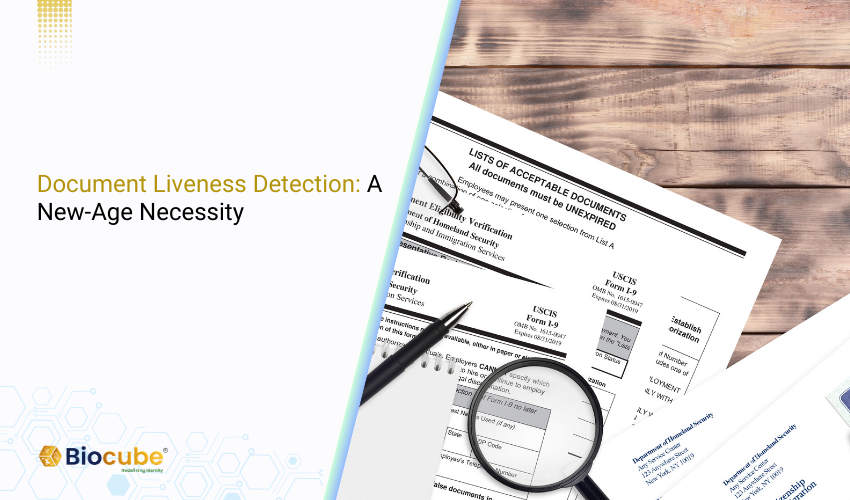
Organizations across the globe often take measures to ensure that the onboarding of new employees happens smoothly and documents match their credibility. Unfortunately, the new-age methods of document spoofing and tampering have made it highly challenging to detect fake papers from real ones.
However, the advancements have led us to document liveness detection, a technique that verifies the credibility of the papers and safeguards from onboarding employees with fake papers. Simultaneously, the technology has become extremely handy in many other instances.
According to research, the Document Verification Market was valued at $4,250 million, and we can expect a CAGR of 16.5% between 2024 and 2030, with the market size growth up to $22,718.40 million.
What is Document Verification?
The process of ensuring that the documents submitted by a person belong to the same individual and showcase authenticity is called document verification. Majorly passports, driver’s licenses, national identity cards, residency proofs, utility bills, and certifications are a few of the standard documents that undergo verification.
What is Document Liveness Detection?
Document liveness detection is a new-age method of ensuring the authenticity of the submitted papers. It identifies if the document has been forged, tampered with, photocopied, etc., and ascertains characters that distinguish fake documents from authentic ones.
While undergoing document liveness detection, the individual could undergo multiple processes, such as physical, behavioral, and static images. The physical process involves verifying the watermarks or holograms. The behavioral method includes moving the document in different directions and ensuring that a natural person is carrying it, avoiding any form of manipulation.
Likewise, static image curates information about the difference in alignment or font styles, making sure that the document isn’t fake or forged.
5 Reasons That Make Document Liveness Detection A Necessity
Preventing Identity Theft & Fraud
In 2022, approximately 27.2 million Indian citizens became victims of identity theft, followed by 13.5 million consumers in the United States and 3 million in Japan. Criminals often forge their documents like passports and other ID proofs to cross borders. They also use false identities to gain access to restricted premises.
Such instances can result in catastrophic circumstances and implicate someone who wasn’t even present during an incident. Moreover, document liveness detection revokes attempts to gain financial access, attain health benefits with false identities, and safeguard the organization’s sensitive information.
Escalating Security at Airport and Seaports
The rising cases of identity theft and fraud have raised security concerns for airport and seaport security. Nowadays, document forgery has become extremely common. However, methods to combat it have evolved.
In July 2024, the Indira Gandhi National Airport Police apprehended 108 fraudulent agents who had potential involvement in passport and visa fraud, resulting in illegal immigration. The number of fraudulent agents has substantially increased from 51 in 2023. Document liveness detection at airports can significantly assist the police and security in such instances.
Streamline Onboarding
Know Your Customer (KYC) is a standard process employed by organizations while onboarding. It involves verifying the credibility of existing bank documents and identity proofs submitted by the recruit.
Involving liveness detection for document verification can significantly reduce the workload of the admin, finance, and HR departments by streamlining the process. Moreover, it will ensure error-free inputs, eliminating the risk of human error.
Highlighting Fake Certificates/Degrees
The fake degree industry was evaluated at $1 billion in 2015 and has significantly grown to reach a sizeable amount of $22 billion by 2022. According to UNESCO’s International Institute for Educational Planning, 4.7 billion global citizens had fake diplomas until this tenure. Fake degrees are problematic as they damage the institution’s reputation.
An educational institution that enrolls a student with such a degree and gets noticed makes qualified candidates lose interest in the institution, as they no longer think that the degree matters or that it is prestigious.
Similarly, any organization that hires a worker with a fake certificate could also become a victim of financial fraud by granting organizational access. Using liveness detection during the enrollment process can significantly reduce or eliminate such risks.
Improving Employee Well-being
According to a survey, 27% of adults worldwide who became a victim of identity theft reported that their mental health was negatively impacted, and 25% said they faced sleep difficulties. On top of that, the majority, 43%, said they spent time resolving the issues created because of the stolen identities.
The inclusion of liveness detection for identity verification can significantly alter this scenario across organizations by eliminating the risk of forged documents. It will dramatically impact the well-being of employees and make them more focused on their work instead of worrying about their identities.
Conclusion
Document liveness detection may seem like a small and nearly invisible aspect of employee organization or individual verification at borders, airports, and seaports; however, it holds prominence.
Organizations across the globe have understood that including liveness detection during the verification process can streamline onboarding, assure the credibility of the identity, reduce the lag in onboarding, and make the process error-free.
Moreover, the technology can even prevent identity theft and fraud, which has been rapidly increasing and significantly impacting the well-being of workers stuck in resolving such issues with the authorities.
On the other hand, security authorities can catch forgeries faster. It also keeps the credibility of the educational institutions intact and keeps the student’s faith in the degrees or certificates issued by the institution.
Schedule a demo with us to implement document liveness detection and other new-age technologies to revamp your onboarding and verification processes.
